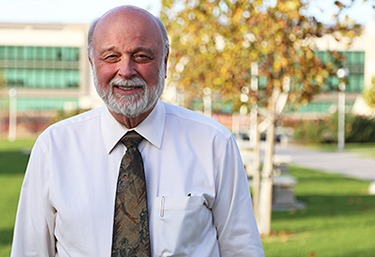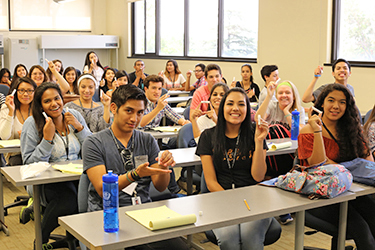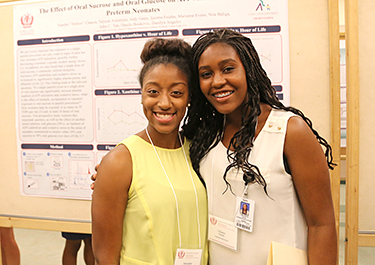 |
| August 2015 |
|
The Pipelines
Besides their basic educational programs, universities concentrate primarily on their downstream strategies — developing graduate programs, encouraging research, maintaining relationships with alumni, etc. We certainly do that and want to emphasize it even more. But with our objective of producing professionals with unique values and perspectives for Over the past several decades, a wide variety of programs have been developed on this campus that play a major role in this pipeline process. Many of these occur during the summer, with visiting students studying in our classrooms and laboratories. These end with “graduations,” giving families, friends, and all of us a chance to share in the joy of accomplishment. Let me share about our six different programs, starting with the youngest students. La Escuelita (K-12 with an emphasis on elementary school children), started some 15 years ago as our students, particularly in the first two years of medical school, sought to impact the local community. They worked through our CKC (Community Kids Connection) program based at the SAC Health System clinic in San Bernardino. Local parents were contacted and offered tutoring for their grade-school children. After some initial hesitancy, the program took off, now with hundreds of our students spending an hour and a half each week, with mainly first through eighth graders, helping them with homework, swapping stories, and providing invaluable mentoring to these kids from tough neighborhoods. Many of these relationships expand into family connections spanning the years. Some of those young “mentees” are now in college and beyond. MITHS, Minority Introduction to the Health Sciences, was specifically designed to acquaint young Adventist African American students with potential careers in the health professions. Championed by Leroy Reese, 15-25 motivated students come from across this country to spend three weeks on our campus each summer. They study under our professors, stay in our residence halls, spend time in our labs and clinics, sharpen their reading and science skills, and observe the life and excitement of the healing professions up close. This program has produced rich dividends, with graduates now having gone on to complete their full professional training in many of our schools. Leroy deserves special credit for doggedly keeping this program going for so many years. The young lives he has impacted will benefit us all for decades to come. Si Se Puede (Yes You Can) started soon after MITHS, with a focus on local Hispanic students. It began as a drive-in program for high school students who had an interest in the health professions. Led by J.C. Belliard, this program gradually expanded, The Center for Health Disparities and Molecular Medicine is part of our School of Medicine, under the direction of Marino De Leon. It has received major funding from the National Institutes of Health for many years and is now one of the largest and most successful programs of this type in the nation. One aspect of the center is encouraging minority students to launch careers in science, and specifically research. Marino offers summer “employment” to around 60 students each summer, coming from high schools, colleges and graduate programs. They work alongside our research professors, tackling real questions that are a part of these research labs. With the experience gained from gathering data, analyzing results and creating scientific posters of their experiments, they mature quickly with pride in their accomplishments. A highlight each summer is the final San Manuel Gateway College, our newest program, is taking shape. This will occupy the third floor of our new Loma Linda University Health – San Bernardino campus being built alongside Interstate 215 in downtown San Bernardino. We just had the “topping out” ceremony, placing the last beam, with scheduled completion of the building by next April. Arwyn Wild, a former principal from the San Bernardino City Unified School District, has been appointed executive director and has started the various tasks of selecting programs to offer, developing curricula, identifying teachers and staff, deciding on equipment, starting the accreditation process, etc. The San Manuel Gateway College will offer a variety of certificate programs to high school graduates, giving them job-entry skills that can bring income to their families and offer a path out of poverty. Our expectation is that some will choose to continue their studies on into degree programs in the health professions, joining a desperately needed cadre of professionals with cultural sensitivity and skills in relating to minority groups in this region. Each of these programs has a particular focus, an audience we hope to reach and impact. They also give Loma Linda faculty, staff and students an opportunity to refine their own commitments and skills in crossing cultural boundaries and developing relationships. We are blessed with these connections, and the thankfulness shared in the eyes and hugs of parents and students is payment enough. Though we have over 11,000 applicants each year seeking one of the 2,000 openings to our regular degree programs, we believe these pipeline programs strengthen that pool in significant ways. EXSEED (Excellence in STEM Experiential Education) is the final program I want to include in this list. It is a bit different from the others, as it focuses on teachers at the secondary and elementary levels, giving them the motivation and skills they need to fulfill one of the most important roles in our society — educating our children. We just completed our fifth summer program in EXSEED, with 100 teachers from across this country as well as Canada, Mexico and Jamaica. Started initially for Adventist secondary school teachers, it has expanded, and this year included 17 local high school science teachers. An intense week of rotating through research labs, discovering new educational strategies, learning to innovate with their new iPads, and developing relationships with colleagues makes up the EXSEED experience. A donor has generously funded the expansion of this program, so new ideas are being considered to extend its influence and strategies. Ron Carter and I are meeting with the Adventist teachers and pastors in Oregon next week to explore with them innovative strategies for their area. Is this appropriate activity for an academic health science center? I think so, particularly as we seek to strengthen our local school systems and support the Adventist educational system around the world. If our ultimate goal is producing quality, principled health professionals, with our values embedded deep in their souls, it must begin early. What better way to enhance the “pipelines” than to bring them to us, giving them greater knowledge of health for themselves and their families, brighter prospects for the future, and a better sense of purpose in this world — perhaps to return to us again as full-time students in the future. Cordially,
Richard Hart, MD, DrPH |
   |
|
Office of the President, Loma Linda University, Loma Linda, CA 92350 Copyright © 2015 by Loma Linda University |
August 13, 2015
Notes from the President -- The Pipelines
Share

 our church and our world, we have realized that just as important is the upstream “pipeline,” the process of motivating and preparing students for the health professions. This must begin early for students to be competitive.
our church and our world, we have realized that just as important is the upstream “pipeline,” the process of motivating and preparing students for the health professions. This must begin early for students to be competitive.  initially to Native American and African American youth, and more recently to all disadvantaged groups. Renamed Summer Gateway Program in 2012, it rotates these students through various activities over three weeks, exposing them to a wide variety of health careers. We graduated 61 students this year, bringing the total to over 642 who have gone through this training since 2005. A special highlight of the graduation exercise, besides seeing many proud parents, was to see previous graduates from every year, now studying here or elsewhere in professional programs. Like all of these programs, they are a work of passion, and J.C., Tina Pruna, and all their colleagues are to be commended for this investment in our future. Particularly exciting was the eight Native American students from reservations across this country who participated this year, staying in the homes of local church families. They are the hope and promise for their local communities.
initially to Native American and African American youth, and more recently to all disadvantaged groups. Renamed Summer Gateway Program in 2012, it rotates these students through various activities over three weeks, exposing them to a wide variety of health careers. We graduated 61 students this year, bringing the total to over 642 who have gone through this training since 2005. A special highlight of the graduation exercise, besides seeing many proud parents, was to see previous graduates from every year, now studying here or elsewhere in professional programs. Like all of these programs, they are a work of passion, and J.C., Tina Pruna, and all their colleagues are to be commended for this investment in our future. Particularly exciting was the eight Native American students from reservations across this country who participated this year, staying in the homes of local church families. They are the hope and promise for their local communities. Research Symposium during which each student and their professor provide a poster conference to our campus showing and defending their results. Their graduation, with proud parents and professors attending, is one of the true highlights of each summer.
Research Symposium during which each student and their professor provide a poster conference to our campus showing and defending their results. Their graduation, with proud parents and professors attending, is one of the true highlights of each summer.